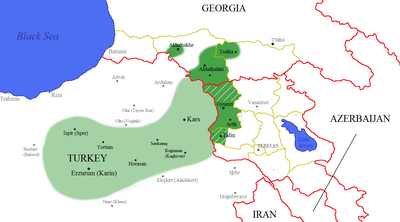Karin dialect

today[1] before 1915–1920[2]
not all areas where the Karin dialect was/is spoken had/have Armenian majority
The Karin dialect (Armenian: Կարնոյ բարբառ, Karno barbař) is a Western Armenian dialect originally spoken in and around the city of Erzurum (called Karin by Armenians), now located in eastern Turkey.
Before
Today, it is one of the most widely spoken Western Armenian dialects, most of which became virtually extinct after the genocide.
History
According to Prof. Haykanush Mesropyan of the Armenian State Institute of Linguistics, the first reference to the provincial dialect (զբառսն զեզերականս) dates back to the 8th century work by Stepanos Syunetsi, who refers to it as զՍպերացն zSperatsn "of Sper". The dialect was also mentioned in the 13th century by Hovhannes Yerznkatsi and in the 17th century by Hakob Karnetsi.[1] In 1887, Alexander Thomson,[5] in his Linguistic studies (Лингвистические исследования) briefly discussed the Akhaltsikhe dialect.[1]
Area spoken
According to the prominent Armenian linguist
Today
In the Republic of Armenia, Karin dialect is chiefly spoken in the cities of
The Karin dialect is also spoken by the
Pronunciation
| բ [bʰ] | — | պ [b] | — | փ [pʰ] |
| դ [dʰ] | — | տ [d] | — | թ [tʰ] |
| գ [ɡʰ] | — | կ [ɡ] | — | ք [kʰ] |
| ձ [dzʰ] | — | ծ [dz] | — | ց [tsʰ] |
| ջ [dʒʰ] | — | ճ [dʒ] | — | չ [tʃʰ] |
Famous speakers
- Jivani (1846–1909), gusan (folk musician) and poet
- Sheram (1857–1938), gusan (folk musician), poet and composer
- Stepan Malkhasyants (1857–1947), Dashnak politician
- fedayee
- Armeniain 1918–1919
- Armen Garo (1872–1923), Dashnak politician, the first Armenian ambassador to the US
- Hamo Ohanjanyan (1873–1947), Dashnak politician, Prime Minister of Armenia in 1920
- Avetik Isahakyan (1875–1957) writer, public activist
- Derenik Demirchian (1877–1956), writer
- Yeghishe Charents (1897–1937), poet
- Ruben Ter-Minasian(1882–1951), military commander
- Hakob Kojoyan (1883–1959), painter
- Grégoire-Pierre Agagianian(1895–1971), Cardinal, leader of the Armenian Catholic Church
- Kourken Yanigian(1895–1984), author, engineer, assassinated two Turkish consular officials in Los Angeles
- Hovhannes Shiraz (1915–1984), poet
- Mher Mkrtchyan (1930–1993), actor
- Vazgen Manukyan (b. 1946), politician, Prime Minister of Armenia 1990–1991
- Levon Ishtoyan (b. 1947), football player
- Harutyun Khachatryan (b. 1955), film director
- Yurik Vardanyan (b. 1956), weightlifter, Olympic, World and European champion
- Levon Julfalakyan (b 1964), wrestler, Olympic, World and European champion
- Israel Militosyan (b. 1968), weightlifter, Olympic, World and European champion
- Mko (b. 1976), comedian
- Gevorg Davtyan (b. 1983), weightlifter, European champion
- Nazik Avdalyan (b. 1986), weightlifter, World and European champion
- Arsen Julfalakyan (b. 1987), wrestler, European champion
- Tigran Gevorg Martirosyan (b. 1988), weightlifter, World and European champion
References
- Notes
- ^ a b c d Mesropyan, Haykanush. "Հայրենակցական միութիւնները և հայերէնի բարբառները (Patriotic associations and Armenian dialects)" (in Armenian). Armenian State Institute of Linguistics. Retrieved 22 March 2013.
- Classification des dialectes arméniens can be seen here
- ISBN 9780080877754.
The destruction of the Armenian homeland and more than a million Armenians by the Ottoman government in 1915–1920 rendered most nonstadard varieties of modern Armenian moribund; with few exceptions the Armenians in the diaspora (primarily Lebanon, France, and notably in the Los Angeles area of the United States) speak only Standard Western Armenian.
- ^ ISBN 9781568591513.
Thus, even today the Erzerum dialect is widely spoken in the northernmost districts of the Armenian republic as well as in the Akhalkalak (Javakheti; Javakhk) and Akhaltskha (Akhaltsikh) districts of southern Georgia
- ^ "Alexander Thomson, a prominent Russian linguist and the first phonetics researcher in Odessa, was born 150 years ago". The press service of the I.I. Mechnikov Odessa National University. 16 July 2010. Retrieved 29 March 2013.
- ^ Hakobyan, Tadevos (1987). Պատմական Հայաստանի քաղաքները (Cities of historical Armenia) (in Armenian). Yerevan: "Hayastan" Publishing. p. 163–164.
- 1897 Russian CensusDemoscope Weekly. Retrieved 25 March 2013.
- 1897 Russian CensusDemoscope Weekly. Retrieved 25 March 2013.
- 1897 Russian CensusDemoscope Weekly. Retrieved 25 March 2013.
- ^ Adjarian 1909, pp. 44–45:Le centre de ce grand dialecte, celebre par sa prononciation douce et agreable, est la ville d'Erzeroum. Il' s'etend au sud jusqu'a Xnus, a l'ouest jusqu'a Erzinghan et Baiburt; les grandes emigrations d'Armeniens d'Erzeroum pendant la derniere guerre russo-turque on elargi les frontiers de ce dialecte a l'est at au nord jusqu'a Eerivan et Tiflis. Quatre autres villes du Caucase (Kars, Alexandropol, Axalkalak et Axalcxa) ont ete fondees par ces emigrants et ont actuellement tout a fait le meme dialecte que les habitants d'Erzeroum.
The center of this great dialect, famous for its soft and pleasing pronunciation, is the city of Erzurum. It 'extends south until Xnus, west and up Erzinghan Baiburt, large emigrations of Armenians of Erzurum during the last Russo-Turkish war on the frontiers of this broadened dialect is at the north to Eerivan and Tiflis. Four other cities of the Caucasus (Kars, Alexandropol Axalkalak and Axalcxa) were founded by these emigrants and currently have quite the same dialect as the people of Erzurum. - ISBN 9780231511339.
- ISBN 9780203641682.
- ^ Baghdassarian-Thapaltsian, S. H. (1970). "OA Portal in Armenia" Շիրակի դաշտավայրի բարբառային նկարագիրը. Լրաբեր հասարակական գիտությունների (Bulletin of Social Sciences) (in Armenian) (6): 51–60. Retrieved 24 March 2013.
{{cite journal}}: External link in|journal= - ^ Adjarian 1909, p. 45.
- ^ Adjarian 1909, pp. 46.
- ^ Hodgson, Katherine. "Armenian Dialects".
- Bibliography

